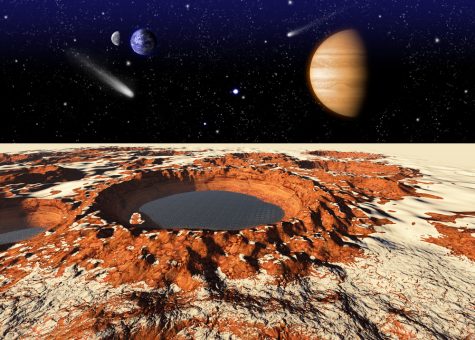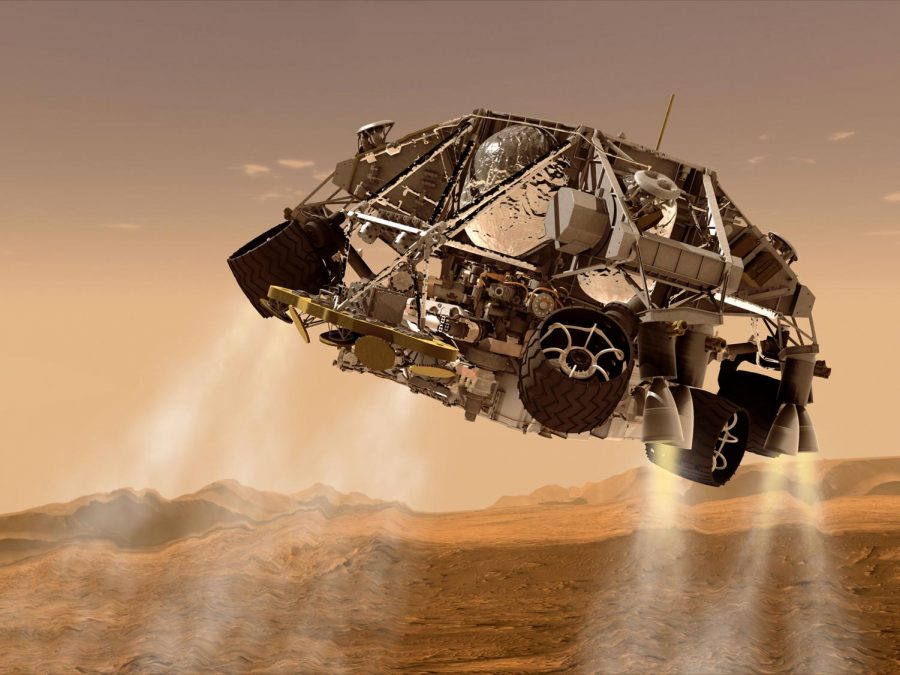Five Years on the Red Planet
A digital remake of the 2012 internet phenomena widely-known as the “Seven Minutes of Terror”; a red-hot Curiosity rover speeding at 14,000 miles per hour must, in seven minutes, come to an absolute stop. NASA experts recall from their calculations that the operation allowed “zero room for error”.
In the summer of 1969, The National Aeronautics and Space Administration (NASA) made its first lunar landing, with an estimated 530 million people watching Armstrong’s televised image and heard his voice as he took “… one small step for a man, one giant step for mankind.”
But why the Moon? Why space exploration at all, for that matter? These are questions that have stirred controversy among American taxpayers ever since the public frenzy from Apollo 11 with Neil Armstrong and Edwin “Buzz” Aldrin had died down somewhere in the early 2000s – and now they have come to echo NASA’s latest mission to planet Mars: the “Curiosity” Mars Rover.
The SUV-sized Curiosity rover is “the centerpiece of NASA’s $2.5 billion Mars Science Laboratory (MSL) mission,” says Michael Wall, senior writer at Space.com and expert in Mars exploration, exoplanet discoveries, astrophysics, and space technology, “… Curiosity’s main goal is to assess whether the Red Planet is, or ever was, capable of supporting microbial life.”
Aside from noticeable differences in size and weight, the new Curiosity rover is equipped with 10 different instruments (some of them of I will list below) for a combined mass of 75 kilograms – two times more than previous “Spirit” and “Opportunity” rovers, whose load included five instruments each.
- Mars Hand Len Imager (MAHLI)
“MAHLI” functions much like a high-powered magnifying glass, giving earthbound scientists a close-up look at Martian rocks and soil. The instrument sits on the end of Curiosity’s 5-jointed, 7-foot long robotic arm, which by itself is already a marvel of engineering.
- Radiation Assessment Detector (RAD)
“RAD” detects radiation, and upon detecting radiation it identifies and measures “all high-energy radiation on the Martian surface, such as protons, energetic ions of various elements, neutrons, and gamma rays.” This instrument is installed primarily to prepare for future human exploration on Mars.
- Chemistry and Mineralogy (CheMin)
“CheMin” studies different types of minerals. According to Wall (see full introduction above and citation below), the instrument “will shine a fine X-ray beam through the sample, identifying minerals’ crystalline structure based on how the X-rays diffract.”
- Dynamic Albedo of Neutrons (DAN)
“DAN” is located near Curiosity’s rear body, and searches for ice and water-logged minerals below the Martian surface. The instrument, according to NASA, should be able to map out H2O concentrations “as low as 0.1” at depths “up to 6-feet.
- Rover Environmental Monitoring Station (REMS)
“REMS” updates scientists back on Earth with daily and seasonal reports on “… atmospheric pressure, humidity, ultraviolet radiation on the Martian surface, wind speed and direction, air temperature, and ground temperature around the rover.” Two sailboat boom-like structures attached to the rover body “record the horizontal and vertical” features of wind speed to characterize airflow on the Martian surface from “… breezes, dust devils, and dust storms.”

“If you’ve kept up with the latest news about Curiosity’s findings,” said Mashable’s Deputy Executive Editor Amanda Wills, “you have probably seen the incredible, high-resolution images she has beamed from the Red Planet.” Indeed, the rover takes these images at “17 different camera angles.” The big question for NASA is how past H2O activity on the Red Planet has influenced the environment. While it is believed that no liquid water exists on the surface of Mars currently, the past record of water can be found in the rocks, mineral, and geological landforms – some of which can only form in the presence of liquid H2O.
Unlike conventional solar-powered rovers in the past, Curiosity relies on “… a much larger thermonuclear-electric generator” that “produces electricity from the heat of plutonium-238’s radioactive decay.” Such an upgrade means two things: first, no longer must operators back home on Earthwork in the short hours of sunlight on Mars; which, in addition to being short, happen to be inconveniently placed during “mid-night and early morning” on Earth; second, the new generator provides Curiosity with power “for at least a full year on Mars, or 687 days on Earth. Either way, NASA’s new Curiosity rover studies Mars in ways no predecessors could before.
Yet, despite the top-line technology packed into Curiosity, most are hesitant from using words like “reliable”, or “developed” or indeed – “mature”, and tend to edge towards meaningless matter-of-fact statements (like “high-tech” or “newest”) on what is otherwise an easily-controversial topic. For one thing; very few people actually understand, or is interested in at all, the topic of Mars exploration. But there won’t be a need for that, because this time again, NASA has courageously given itself the critical feedback it needs: “The… biggest risk to the mission,” according to NASA Inspection General Paul K. Martin, “is the sampling system that will be used to collect and store samples of Martian rock and soil” that a “… future mission will gather for return to Earth.” A 2017 article from Space News also quoted the NASA Inspection Officer pointing out the “immaturity” of the “critical technologies related to the Sampling System”, which, he later adds, “is a concerning issue”, for “[being] the rover’s most complex new development component”, problems “are likely to eat into the Project’s schedule reserve and, in the worst-case scenario, could delay launch [in 2020].”
And now to answer the obvious question: Why a mission to Mars? Answers may vary from person to person: whether they are learned or uninformed; cynical or optimistic; an adventurous human or indeed – a particularly human-friendly Martian. But for American astrophysicist and author of “Welcome to the Universe” Neil deGrasse Tyson, the answer is simple: because it’s the most habitable for humankind. Mars “has a 24-hour day,” he says, and “… its axis is tilted compared to with its orbit, just as Earth is tilted on its axis. This means Mars goes through seasons.” When asked what he thought were the odds of finding evidence of life on Mars, Tyson answered not a little hesitant. “High,” he said, “certainly higher than 50 percent. And by life, I refer to fossil life, not current life; and simple life, bacteria or microbes. Water is the key.”

David Guo is a Grade 10 at St. George’s School. Guo joined the school in Grade 9, and has since developed an interest in the Liberal Arts. He is the...







